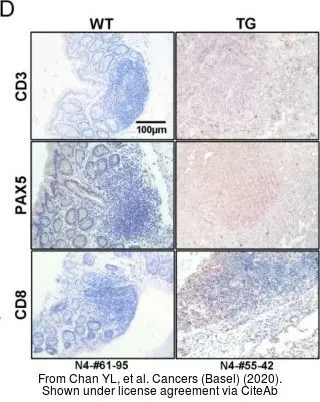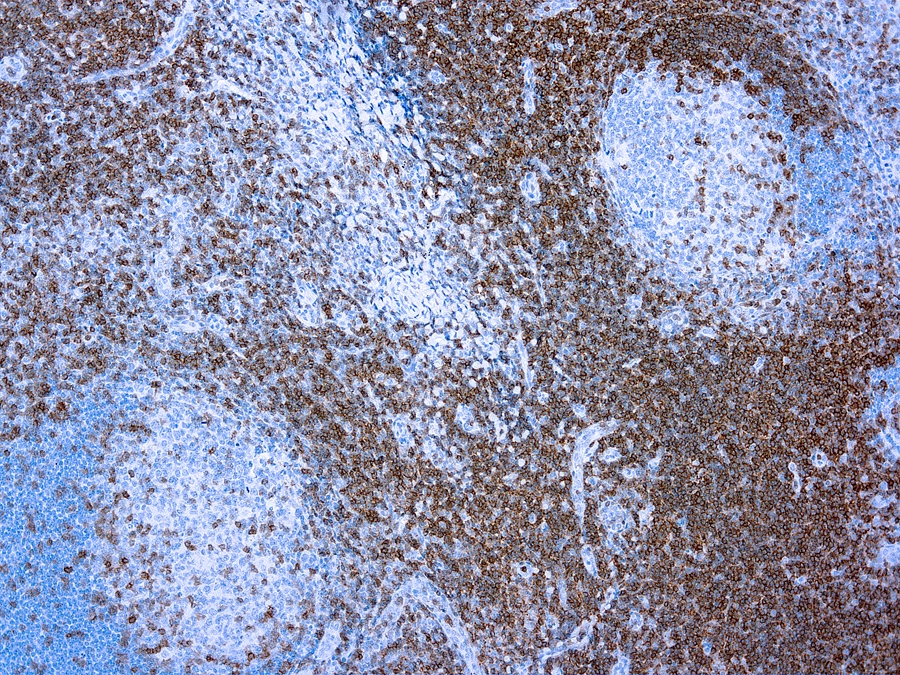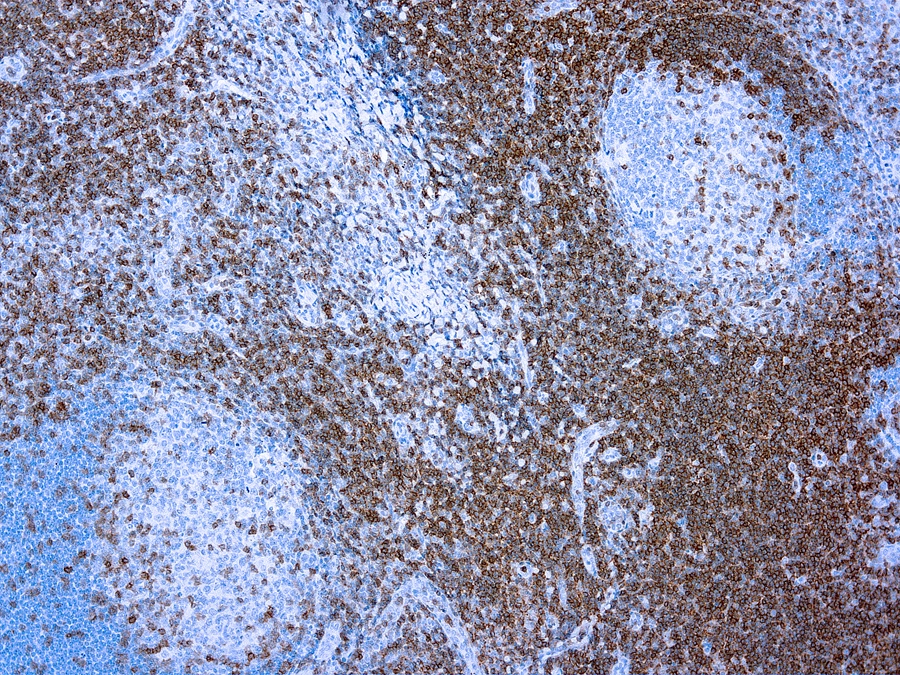![IHC-P analysis of human tonsil tissue using GTX16669 CD3 antibody [SP7]. IHC-P analysis of human tonsil tissue using GTX16669 CD3 antibody [SP7].](https://www.genetex.com/upload/website/prouct_img/normal/GTX16669/GTX16669_20191203_IHC-P_5_w_23060620_244.webp)
IHC-P analysis of human tonsil tissue using GTX16669 CD3 antibody [SP7].
CD3 antibody [SP7]
GTX16669
ApplicationsFlow Cytometry, ImmunoFluorescence, ImmunoCytoChemistry, ImmunoHistoChemistry, ImmunoHistoChemistry Frozen, ImmunoHistoChemistry Paraffin
Product group Antibodies
TargetCD3D
Overview
- SupplierGeneTex
- Product NameCD3 antibody [SP7]
- Delivery Days Customer9
- Application Supplier NoteIHC-P: 1:25-1:50. *Optimal dilutions/concentrations should be determined by the researcher.Not tested in other applications.
- ApplicationsFlow Cytometry, ImmunoFluorescence, ImmunoCytoChemistry, ImmunoHistoChemistry, ImmunoHistoChemistry Frozen, ImmunoHistoChemistry Paraffin
- CertificationResearch Use Only
- ClonalityMonoclonal
- Clone IDSP7
- ConjugateUnconjugated
- Gene ID915
- Target nameCD3D
- Target descriptionCD3 delta subunit of T-cell receptor complex
- Target synonymsCD3-DELTA, CD3DELTA, IMD19, T3D, T-cell surface glycoprotein CD3 delta chain, CD3 antigen, delta subunit, CD3 delta, CD3d antigen, delta polypeptide (TiT3 complex), CD3d molecule, delta (CD3-TCR complex), OKT3, delta chain, T-cell receptor T3 delta chain
- HostRabbit
- IsotypeIgG
- Protein IDP04234
- Protein NameT-cell surface glycoprotein CD3 delta chain
- Scientific DescriptionThe protein encoded by this gene is part of the T-cell receptor/CD3 complex (TCR/CD3 complex) and is involved in T-cell development and signal transduction. The encoded membrane protein represents the delta subunit of the CD3 complex, and along with four other CD3 subunits, binds either TCR alpha/beta or TCR gamma/delta to form the TCR/CD3 complex on the surface of T-cells. Defects in this gene are a cause of severe combined immunodeficiency autosomal recessive T-cell-negative/B-cell-positive/NK-cell-positive (SCIDBNK). Two transcript variants encoding different isoforms have been found for this gene. Other variants may also exist, but the full-length natures of their transcripts has yet to be defined. [provided by RefSeq, Feb 2009]
- Storage Instruction2°C to 8°C
- UNSPSC12352203
References
- CDC7 inhibition induces replication stress-mediated aneuploid cells with an inflammatory phenotype sensitizing tumors to immune checkpoint blockade.Read more
- Productive HIV-1 infection of tissue macrophages by fusion with infected CD4+ T cells.Read more
- Shed syndecan-2 enhances colon cancer progression by increasing cooperative angiogenesis in the tumor microenvironment. Jang B et al., 2022 Mar, Matrix BiolRead more
- Dysbiosis exacerbates colitis by promoting ubiquitination and accumulation of the innate immune adaptor STING in myeloid cells.Read more
- Hydroxysafflor Yellow A Inhibits Staphylococcus aureus-Induced Mouse Endometrial Inflammation via TLR2-Mediated NF-kB and MAPK Pathway. He S et al., 2021 Jun, InflammationRead more
- Developing an enhanced 7-color multiplex IHC protocol to dissect immune infiltration in human cancers. Sun Z et al., 2021, PLoS OneRead more
- A Mouse Model of Proliferative Vitreoretinopathy Induced by Intravitreal Injection of Gas and RPE Cells. Heffer A et al., 2020 Jun, Transl Vis Sci TechnolRead more
- TIAM2S Mediates Serotonin Homeostasis and Provokes a Pro-Inflammatory Immune Microenvironment Permissive for Colorectal Tumorigenesis. Chan YL et al., 2020 Jul 8, Cancers (Basel)Read more
- IRAK4 inhibition: a promising strategy for treating RA joint inflammation and bone erosion. Umar S et al., 2021 Sep, Cell Mol ImmunolRead more
- Modulation of tumor microenvironment using a TLR-7/8 agonist-loaded nanoparticle system that exerts low-temperature hyperthermia and immunotherapy for in situ cancer vaccination. Chen PM et al., 2020 Feb, BiomaterialsRead more



![IHC-P analysis of human tonsil tissue using GTX17143 CD3 antibody [F7.2.38].](https://www.genetex.com/upload/website/prouct_img/normal/GTX17143/GTX17143_20191203_IHC-P_30_w_23060620_353.webp)


![FACS analysis of human peripheral blood lymphocytes using GTX01459-06 CD3 antibody [Hit3a] (FITC). Solid lone : primary antibody Dashed line : isotype control antibody amount : 0.5 microg (5 microl)](https://www.genetex.com/upload/website/prouct_img/normal/GTX01459-06/GTX01459-06_20200428_FACS67_w_23053121_391.webp)
![FACS analysis of human peripheral blood lymphocytes using GTX01459-07 CD3 antibody [Hit3a] (APC). Solid lone : primary antibody Dashed line : isotype control antibody amount : 0.25 microg (5 microl)](https://www.genetex.com/upload/website/prouct_img/normal/GTX01459-07/GTX01459-07_20200428_FACS2_w_23053121_569.webp)